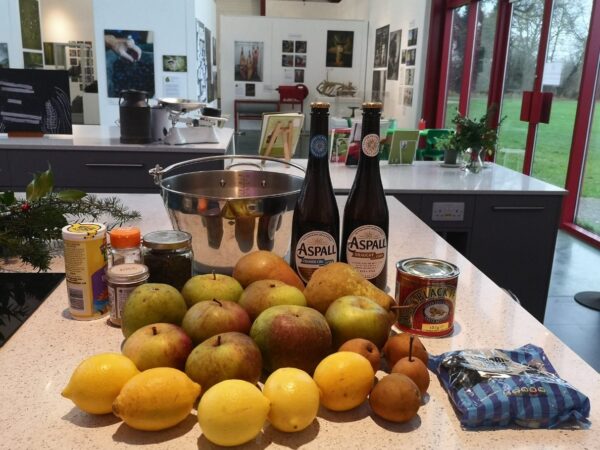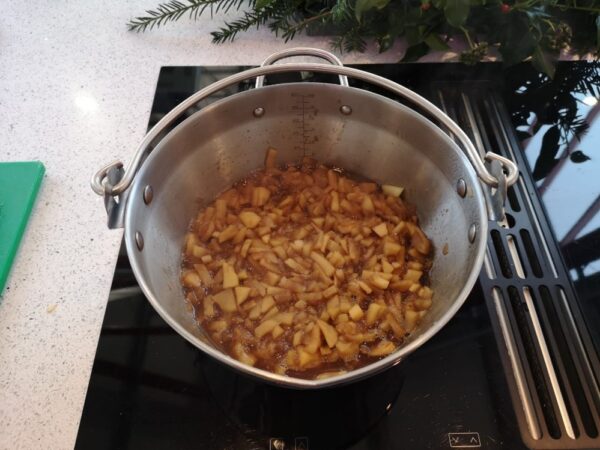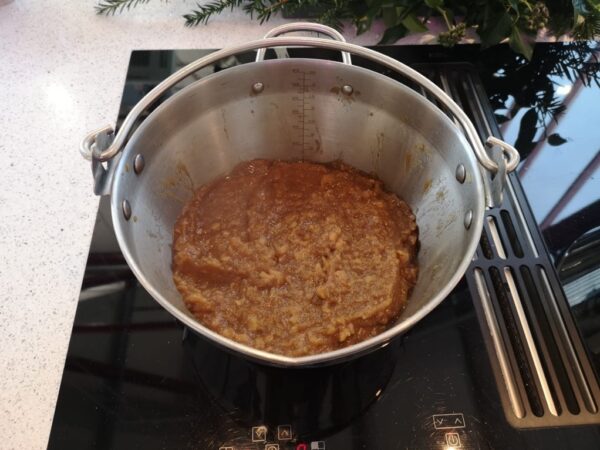On Black Butter: The Flavours of a Dying British Love-affair with Apples
Lekvar (Hungary); Povidl (Austria); Пови́дло (Russia); Rheinisches Apfelkraut (Germany); Appelstroop (Netherlands); Sirop de Liège (Belgium) ; Raisinée (Switzerland), or just plain Apple Butter. Where humble fruits have sprouted, long cook times, dark rich outcomes and an absolute pig of a cauldron cleaning session have been sure to follow.
Yet, within a sticky tapestry of preserves, flavour combinations on the Channel Island of Jersey continue to stand out. At least for now.
With its alchemy of local cider, apples, sugar, black treacle, lemons, liquorice and festive spices, Jersey Black Butter, or Du Nièr beurre wafts molasses caramels rivalled only by the spectacular theatre and cultural spectacle behind each batch’s creation.
A community tradition
Black Butter traditionally belonged in the pantries of Jersey’s Jèrriais – speaking farming communities. With apple harvesting all but wrapped up and another channel winter creeping closer, it was time for families, friends, and work colleagues to open their farm doors for a séthées dé nièr beurre – a Black Butter party.
Apple and cider surpluses needed to be used, a daunting task lay ahead. Why not combine it with cider, singing and storytelling, for a two-day sesh pre-industrial style?
First in the bâchin (copper cauldron) went the gallons of cider, reducing to a near syrup. Next came the barrels of apples and other ingredients. Finally, just to finish things off, 24-30 hours of stirring with prolonged conversating more demanding than a long-haul flight.
Continuous stirring is essential to prevent burning, so Butter partygoers have to take shifts turning with a rabot (stirrer) – specially designed to stir a distance away from the steam and lapping flames.
Slowly but surely, as dark turns to light, light turns to dark. The trick, creating concentrations of natural sugar that would avoid spoilage to the mainland.
One report from a local parish séthées dé nièr beurre in 2000, details the use of 31 barrels of apples, 21 gallons (248 pints) of cider, and 461 jars at the end of it all. When these Islanders Butter, they Butter hard.[1]
Butter cooking isn’t just to toil over a cauldron as wood crackles and sugar spits, it’s also the collecting of wood by men to keep a fire lit for 30 hours, the peeling of hundreds of apples by women, a true community effort.
In this sense, Jersey Black Butter is in a way a preservation not just of apples, but of bonds to the land, seasons, and to each other. It is also a condiment with a shelf life far longer than even the most robust of supermarket easy peelers.
A boozy sticky history in a cauldron
Apples are special in Anglo-Brittonic food histories. In our less predictable northern climate, this dependable fruit has always been there, diversifying with every settler’s contribution. From crab apples thousands of years old to Norfolk Biffins used at the Food Museum. According to the Orchard project, 2500 British varieties exist today (of 7000 globally).[2]
It’s difficult to imagine the once booming orchard scape of the UK south. Where apples once flourished, now there are grapes, and where cider was, wine has taken its place. Now three quarters of apples in the UK are imported.[3] Elsewhere, our vintage is parodied in alco-pop form doomed only to compete with cheap beer…probably owned by the same company.
Yet in the defiantly real scrumpy of small-scale cider farms, our love for crumble and yes, in Jersey Black Butter, we retain fragments of something truly colossal.
Amongst historical cider-apple giants like Somerset or Herefordshire, Jersey’s contributions were staggering for an Island only 5 miles long and 9 miles wide.
During the reign of Charles II, UK cider expert James Crowden writes of 24,000 hogsheads or 10,368,000 pints being produced yearly.[4] By 1795, this number had risen to 12,960,000 pints.[5] In 1801, a slightly lower 8,640,000 pints is still jaw-dropping when you consider that two thirds of that cider was consumed locally.[6] Jersey had a population in the early 20,000s at the time, that’s enough for over 300 pints a person annually![7]
Endangered flavours
Yet, where a map commissioned by the Duke of Richmond in 1787 displays an Island covered by 16 percent orchard, factors including the rise of potatoes in the 19th century, and crop replacement during Nazi occupation have contributed to the steady decline of apple island culture.[8]
These days only around 70 acres of orchards remain on Jersey, according to the most recent land survey in 2017.[9] Without them, apple products have lost their relevance. Black Butter remains only in diminished dislocated form.
As one Islander, Lily, told us:
Not every family owns a Butter bowl. I’ve heard of [Black Butter], you can find it at markets and its made at a few events. But it’s not a thing.
For now, Jersey Black Butter holds on. Through occasional séthées dé nièr beurre held by the likes of the National Trust and through limited businesses making the product itself and other Butter-flavoured products like fudge or chutney, it remains.
Each prevailing jar seals the spirit of a bygone era. Each spoonful, the flavour of a world where apples were livelihood, community, and identity.
Recipe: East Anglian Black Butter
In this version we’ve captured the key flavours of the original le nier neurre whilst adapting to our own local produce, working schedule and lack of a girthy cauldron.
Instead of a rich naturally concentrated preserve achieved with days of cooking over a fire, we’ve made our Black Butter for a shorter amount of time, on a lower heat, with more sugar. Try our recipe out for yourself and see what you think!

Ingredients:
1 litre of your best available local cider
(Dry to Medium Dry).
2500g of your best locally grown orchard varieties, peeled and diced.
(We’re using a blend of Norfolk Biffins, Shuttleworth pears, and Quinces).
1,750g of Demerara Sugar
(Adjust to taste but remember, under 60% sugar content means a risk of spoilage at room temperature)
4 tablespoons of finely diced liquorice
Two lemons juiced
3 tablespoons of black treacle
(black treacle, Black Butter, go figure)
2 teaspoons of ground ginger
1 tablespoon of mixed spice
(The one that has cinnamon, nutmeg, cloves, pimento etc. Not curry powder or fajita mix!)
Steps:

1)Reduce cider to a quarter of the volume (1hr 30 for us but it depends on the heat and pot surface area).

2)Add fruit and liquorice, cooking the contents down on a low heat to a reduced pulpy consistency (1 hr 30).

3)Add sugar, treacle, and lemon juice. Continue cooking the contents on a low heat, stirring vigilantly to avoid sugar burning on the bottom.

4)At the point of the desired reduction (Like the one seen in the photo), add spices, stir for 10 minutes more and take off the heat. Once cooled, your black butter is complete.

Happy flavour week from the Food Museum!
[1] La Section de la Langue Jèrriaise. 2000. ‘Preserving an Old Tradition’. In: Black Butter.
[2] The Orchard Project. 2016. ‘The Amazing World of Apple Varieties’. In: The Amazing World of Apple Varieties – The Orchard Project.
[3] Mark Riddaway, 2020. ‘Apples’. In: Borough Market: Edible Histories, p.18.
[4] James Crowden. 2021. ‘Jersey Cider’. In: Cider Country: How an Ancient Craft Became a Way of Life, p.287.
[5] Crowden. 2021, p.289.
[6] Crowden, 2021, p.288.
[7] Mark Boleat. 2014. In: Jersey’s Population: A History, p.2-15.
[8] Crowden. 2021, p.288.
[9] Government of Jersey. 2020. In: gov.je/government/freedomofinformation/pages/foi.aspx?ReportID=3765.
Written by Hamish David
Share this article



